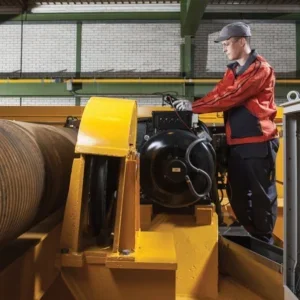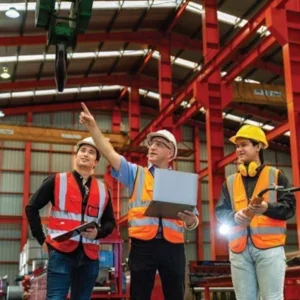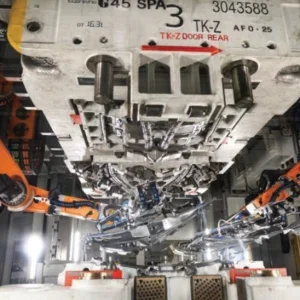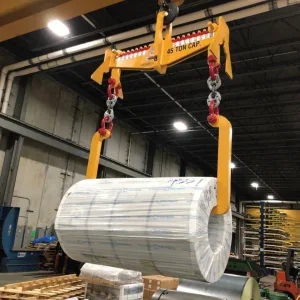Car and other vehicle production has picked up since the depths of the 2008 financial crisis and with it the need for lifting equipment.
With the advent of robotised production lines this is increasingly found at the start of lines for the heavy work moving massive steel coils and for the presses where it is moulded for panels.
But equipment for lift and move operations is still needed on many production lines and major suppliers offer both large overhead cranes and smaller equipment along the production sequence.
Finnish manufacturer Konecranes says that it has equipment for all stages of production from its CXT overhead cranes for heavy lifting and the Smarton system for controlled and precision lifting from 6.3 to 250t with a single trolley and up to 500t with two. Smaller equipment is made for use along the line including workstation jib cranes.
These could be equipped with its ATB AirBalance lifting unit, a pneumatically driven winch system for precision lifting and placing of components up to 350kg.
The unit works with load weight compensation to allow the operator to "float" objects precisely into position.
Proportional or balance control is supplied or a combination of the two. Smart features
The AirBalance will also fit onto Konecranes aluminium rail workstation cranes, which come in the XA and XM ranges for lifting over the production line. Those might also be fitted with chain hoists.
Konecranes automotive sector specialist Marco Piela says that "smart" features are increasingly available for crane operations. These include a variety of functions on the basic control unit to modify the lift operation. First among them is sway control which smoothes the stopping operation of a load movement, reducing time-wasting and potentially dangerous induced load swings, and a variety of targeting programs that allow a load to be moved automatically from a preset start station to a designated end point.
Inching, and variable micromovement settings allow loads to be controlled more precisely. The smart movements make work safer and also reduce stresses on both crane components and the building structure they are mounted within he says.
Piela says that a major development at present is in the "industrial Internet". For Konecranes this means what could be called the "intelligent" crane, fitted with detectors and instruments which can be monitored for use and wear, and even be connected for diagnosis of problems and breakdowns.
Konecranes has a modular system called Truconnect Remote Services. Providing the customer allows access to the data, this will collect information on use and operation of cranes, which allows better maintenance decisions and pre-emptive component replacement to reduce downtime.
Increased production
Safety warnings can also be sent if there are overloads or overheating, displayed by email or mobile phone messages and the system will also allow for remote two-way connection with Konecranes engineers who can assess the crane for client.
One recent application of Konecranes has been at Volvo’s truck works in Umeå in northern Sweden where a new stamping plant has been established for increased production. An important aspect is changing the dies in the presses and to speed this work, the company has replaced traditional chains around the heavy dies with its own design of lifting clamp, which is faster and safer.
A Konecranes semi-automated overhead unit was selected to go with the device. It uses two trolleys for basic stability and additional anti-sway control. Konecranes engineers then worked with Volvo’s team to design the whole system which also makes use of a Siemens S7 PLC and Profibus absolute encoders for precise positioning.
Heavy investment
Speeding up die stamping is an increasingly significant aspect of crane provision for other makers too according to Chris Lindley-Smith, sales director at the Street Crane Company in the UK where car production is seeing heavy investment at present.
Methods of "lean production" developed originally in Japan are increasingly applied for more streamlined workflow and better equipment utilisation, he says. Press shops are a good example of this revolution he continues. To avoid high initial investment in multiple single process presses, Japanese makers developed "die swapping" to allow one press to stamp multiple parts.
But the swap operation interrupts production and a rapid switching method had to be developed to move dies, which can be stored four or five high.
"In a typical set-up four of five presses are arranged in a cell to sequentially stamp the shape, perforate and profile the panels. In a standard shift each set of dies could be swapped up to 15 times" explains Lindley-Smith.
"Die swaps are automated with the current set of dies posted out on one side and a new set introduced from the other. Cranes play a pivotal role in positioning each set of new dies and transferring the previous set to an inspection area where any damage or wear can be repaired."
A recent crane installation for a major prestige car manufacturer shows the level of complexity. The crane in use has a rating of 60t safe working load. It has twin hoists, each of 60t, operated singly or in tandem. Duplicating the hoists provides redundancy to continue work in case of outage on one hoist.
The company is also able to deploy both hoists when handling more cumbersome loads with a load summation device to stay within safe working load.
Precision engineering
The press dies are precision engineered and so extreme care is essential in their handling and positioning. For this reason inverter control is deployed on all motions ensuring safe stable die movement and location. The go-to positions for placing the dies are fully automated with laser guiding to ensure precision location. Street’s recent installations also include overhead cranes for commercial vehicle body builder Tiger Trailers. One 5t and two 3t overhead cranes were installed last spring and an additional 5t crane has been ordered.
Increased production
Tiger is a new entrant to the commercial vehicle market, which started last April winning orders from logistics and retail companies for their trailer vans, curtain side trailers, double deck trailers and bespoke rigid bodywork. They are made on two separate production lines.
Another installation for fast retooling in a stamping plant has recently been made by Germany’s Stahl Crane Systems, via its Indian partner Sparkline. The installation developed by Sparkline for a new Ford plant in Sanand, India uses seven cranes, equipped with winches, wire rope hoists and crane components from Stahl.
The cranes operate on two levels and in some cases can travel over one another. Wireless communication between the crane bridges and a complex anti-collision system permit the cranes to operate in various safety zones.
Ford specified high speeds for the lifting and travel motions to enable the press and stamping line to be retooled quickly. "A high-end crane system of this type is unique in India at present," Sparkline managing director Doshi declares.
Automated retooling
The installation allows autmoated retooling. When the operator has entered the destination number of the tool, the crane travels to a selected position at up to 60m/min, following prescribed routes and around safety areas. A minimum positional accuracy of ±6mm required.
When the crane reaches the machine, a grab lifts the tool, the crane travels automatically to the storage area and sets the tool down in a free space.
Meanwhile another manufactuer from Germany, Eepos, is rather unusually celebrating the removal of one of its systems from a factory in Ulm. The firm makes aluminium crane systems for production lines and in 2008 installed one for a Iveco plant making the ladders for fire engines.
Upgraded production
The Magirus plant has recently been upgraded for production of some the fire engine trucks themselves. For this the production halls had to be reshaped removing the old lines which had used some 2km of Eepos aluminium overhead rail crane system. The surprise was the good condition of the rails and the special plastic rollers that carry the hoists.
Mechanical maintenance engineer at the plant, Dieter Wettengl says that the surprise is how much of the existing cranes and components could be re-used. "We did not expect that the material would come down in such an excellent condition from the ceiling after 5 years under full operation."
Apart from the resilience of the system, the refit has also illustrated the advantage of its light structure says Eepos. The refit had to be done on a tight schedule and the aluminium rails meant dismounting was simple and speedy.
"Even 6m long parts could be held by one person" says Wettengl and nothing more than elevating platform, assembly tools for screws and nuts and the employees themselves were needed – nothing more.
All rails and components were sorted and stored with some 700m of rails re-mounted in new positions. The remaining rails and parts are being used at other Iveco Magirus sites.
In America meanwhile manufacturer Star Cranes points to another trend in automotive plants, the need for customised solutions and a willingness by the manufacturer to be versatile, both in the application and fixture devices to go with the crane.
One specially developed device uses an arm to place product in the box. A custom made fixture was also produced to allow a tractor differential to be lifted, flipped, and turned for assembly processes.
Star Crane will tackle both types of installation it says.






